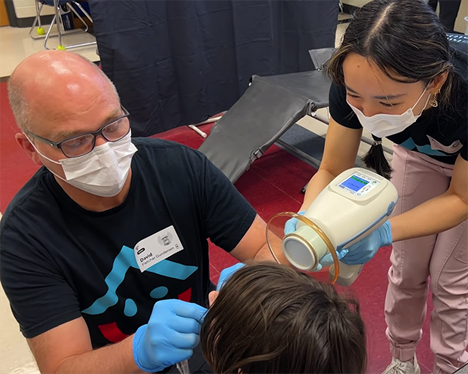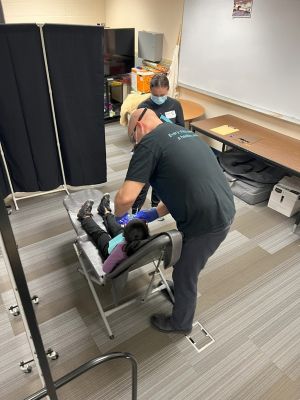Enter your email to receive the CareQuest newsletter:
June 16, 2025
For children across the US, accessing oral health care has its obstacles. The main one?
“They don’t have a choice in the matter,” says Stacy Nehmer, Executive Director of More Smiles Wisconsin, a nonprofit that provides health-related community care to people in need.

Parents who work during the day may struggle to find time to take their kids to the dentist, Nehmer adds. They may not have transportation, may not be able to find a dental office that accepts Medicaid, or may not feel comfortable navigating the system if English is their second language.
They may also be misinformed.
“Something that we often hear in this program is parents thinking, ‘Okay, well, the decay is in a baby tooth that’s going to fall out anyway,’” Nehmer says. “Yes, baby teeth do fall out, but it could be years before they do. And in the meantime, the decay can spread to other teeth, turning into the child needing a crown or extensive work.”
Organizations like More Smiles Wisconsin and Nicklaus Children’s Foundation in Florida have been working for years to help children get access to oral health care. (Last year, CareQuest Institute awarded 10 organizations, including More Smiles Wisconsin and the Nicklaus Children’s Hospital Foundation, $125,000 each to promote school-based or school-linked oral health programs that drive systemic change.) The two organizations have employed several strategies to improve access to care, including sending dental professionals to schools to perform exams and making recommendations to parents.
They’ve made progress and can point to many successes, but they were still seeing gaps in the system.
“Many times, we encountered children who either had an infection, or they had extensive dental needs, and we would give them a referral to go to a local dentist or to come to our clinic,” says Oscar Arevalo, DDS, Program Director of the Pediatric Residency Program at Nicklaus Children’s Hospital. “And when we returned to that particular facility three or six months down the road, we would find that the kid was still in pain and his or her dental needs had not been addressed.”
Both organizations realized it was time to try something new.
Prioritizing a Population in Need of Providers
The Nicklaus Children’s Hospital Foundation in Florida helps students in the Miami-Dade Country public school system access oral health care.
“There are many kids in our public school system who are from the working poor,” Arevalo says. “A collaboration with Miami-Dade County Public Schools, the third-largest school system in the country, made sense, and our mobile dental team goes out three days a week to visit those schools. In addition, Nicklaus Children’s dental team visits churches, and community-based organizations to help children in need.”
But Arevalo says many times the team would return a few months later to find that the child still had the infection or dental need.
“We realized we needed to have somebody who would connect the families with a provider — either us, or a community health center, or a local dentist who serves the Medicaid patient population,” he says.
A few years ago, the organization hired a community dental health coordinator to help eligible families enroll in Medicaid and connect children to the care they need.
“We wanted to ensure that the kids got their treatment completed and would not continue falling through the cracks,” Arevalo says.
But then history started to repeat itself — this time with the growing Haitian community in South Florida.
“We were encountering the same situation,” Arevalo says. “So, there were many of these Haitian children where they have, or in some cases did not have, dental benefits, but they do not have a pediatric dentist.”
A potential solution? The organization is using the funds from CareQuest Institute to hire another community health coordinator — but this one is working specifically with the Haitian population. “She’s Haitian, so she understands all the cultural aspects,” he says. “She’s very active in her church, and she has been able to establish very meaningful connections in the community for us. She has opened a lot of doors for us.” They are already seeing some results. “We have seen a larger influx of these children coming not just to our clinic, but also to our partner medical center,” Arevalo says.
Making It Easier to Access Dental Care
Nehmer at More Smiles Wisconsin loves the idea of having a community dental care coordinator, like the one with Nicklaus Children’s, to help educate parents about oral health, access transportation, and overcome language barriers.

patient's teeth in chair
“I’m learning a couple of the grantees from our peer learning groups have this person in place and have had really great success with it,” she says, pointing to a unique feature of CareQuest Institute’s philanthropy model. “I think that is something that every community could benefit from.”
Although the organization currently does not have a community dental care coordinator, More Smiles Wisconsin does have their Hometown Smiles Program. With that program, a dentist, dental assistant, support team, and administrative assistants go to a school and provide comprehensive exams for every kid who’s enrolled and in school that day.
“It is not only for children insured through Medicaid,” Nehmer says. “They provide exams for all children in every grade.”
If the child does not have a dental home, the dental team tries to find a local private clinic that is willing to provide oral health care for them.
“We have contracts in place with some dentists, so if they wanted reimbursement for their services, we would bill Medicaid and then reimburse them for whatever care they delivered,” Stacy says. “We've been very fortunate that every office that does accept kids has done the work charitably. They have not asked for any portion of reimbursement.”
Looking at the school district they cover, they realized that getting the children into a dental home had long-lasting rewards.
“About 70% of the kids that we’re seeing at follow-up had no additional treatment needs,” Stacy says. “So, once we were able to connect them with a dental home, their oral health stayed in good shape.”
But some dentists are hesitant to be a part of the program. If they don’t accept Medicaid at their clinic, they believe it could be a complicated process to enroll in and then bill Medicaid. That gap led More Smiles Wisconsin to apply for the CareQuest Institute grant.
“We came up with informational sheets on enrolling in Medicaid and offering assistance to offices who are interested in enrolling,” Nehmer says. “The grant funds have definitely helped with the outreach.”
Nehmer says dentists are also more inclined to listen to one of their peers, so with funds from the grant, More Smiles hired a dentist champion to get them in the doors of these offices.
“He is spending time in the schools performing the exams, recruiting other dentists,” she says.
On top of that, the organization is using the grant funds to help with processes within the program. More Smiles acquired a standalone server to store information like health records and X-rays when they’re at a school without secure internet access.
“These funds have helped us work through these processes to make it as easy as possible for the schools to want to participate in the program,” Nehmer says.
She hopes programs in other communities can benefit from the processes More Smiles developed.
“We’re trying to just educate other communities so they don’t have to recreate the wheel,” she says. “We can encourage them to recruit their own dentists, their own support staff. We’re just giving them the model and showing them the results.”